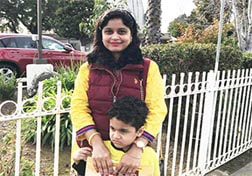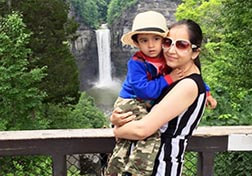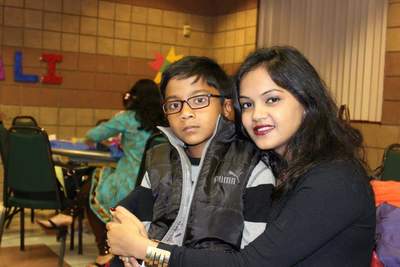
BY DEVIKA C. MEHTA
LOS ANGELES, CA - When due to an emergency, Parul returned from the US after a stint of two years, she wasn’t sure about the difficulties that lay ahead of her in India. Soon, her troubles began when she tried getting her daughter admitted to first grade in an Indian school- reason being the difference in curriculum and...
LOS ANGELES, CA - When due to an emergency, Parul returned from the US after a stint of two years, she wasn’t sure about the difficulties that lay ahead of her in India. Soon, her troubles began when she tried getting her daughter admitted to first grade in an Indian school- reason being the difference in curriculum and...
pattern of education of both countries. Most parents are aware about the hassles of relocating kids from the US to India, especially when parents are on a visa; and, when it comes to education, the trouble turns into a burdensome job.
Growing up in India one often comes across parents discussing standards of Indian education and its practices. But the real truth stands out when NRIs actually get to compare Indian vs American education.
Indian elementary education on one hand is considered strenuous and pressured while the American system adopts a more stress-free and practical approach.
Kanika Kohli’s 6 year old Advik goes to a Burbank school close to LA and is displaying extraordinary skills in science and space related issues. She applauds the American system by saying, “My child is not overburdened. Though he gets homework and projects daily, but mentally he is not stressed, unlike kids in India where more stress is laid on theory and regular exams.”
Another LA resident Rakhee Jaiswal from Arcadia, whose child is now in Grade 8 feels, “Though elementary education is less stressful, pressure to perform and compete is even more at middle and higher school level here. Unlike American parents, we Indians always lay stress on the need to perform. Also, Indian schools have co-curricular activities but how many of them are actually able to convert these into lucrative jobs. Here, volunteer work helps you get selected for so many scholarships.”Parent of two school going kids, Afrin Lazib, who is based in Wisconsin, agrees, “US education has room for thinking and intellectual development. While in the Indian system the student’s memorizing ability is still the key factor which decides your exam results. ‘’
However, some Indian parents who are still living in the US, believe differently.
Nisha, a working parent, whose 5 year old has just started in Kindergarten says, “I am always burdened with a thought- Will my kid be able to cope with the study level in India? Back in India children of his age are learning different languages and have a lot of curriculum which is totally missing out here. Being on a non-immigrant temporary visa we just can’t think of settling down here in the US. So we are kind of never settled in our lives and our kids would always be at the learning stage and coping with different cultures and education.”
Kanchan Kavathe Gaur, the mother of a 3 year old, who lives in Park La Brea feels ``Indian education has helped us all in some way or another. In America you get exposed to a lot of co-curricular activities and everyone is appreciated. So a child is not hungry or struggling to move ahead. The pressure in Indian schools only make kids stronger in later life.”
Another parent couple in the US Neetu Sharma and Rajinikanth share a similar thought, and highlight positives and negatives in both systems. Neetu, who was also a teacher back in India, says, “There is a huge difference in both the education systems. Kids returning to India face a lot of difficulties in terms of writing level (fast & perfection based in India), homework load (more in India), carrying books to school, giving examinations & tests (especially in lower grades) and most importantly moving from a concept & exploration based study to a traditional approach which is based on reading and memorizing. Another important factor is age. Elementary school starts in the US at age 5 when kids start basic writing skills (or tracing) whereas in India it starts approximately at age 3 and progresses very fast. Last but not the least, learning the vernacular language is also a problem for migrating kids between grades 1-5.”
No doubt the pressure of education and standards affect several parents differently. In fact, due to the education differences, some mothers have voluntarily decided to move back to India even though their spouses are still living in the US. The mother of a 7- year- old, Mukta Saxena strongly believes that elementary and middle school level of Indian education is better than the US. “Yes, there is a huge difference between the curriculum. I know people who were literally stressed once their kids went back to India. After all if they need to face career challenges in India then studying abroad makes no sense. Also kids are able to stick to their roots and culture, and for higher education they can always turn to the foreign land.”
She even questioned, “Today, are not Indians performing well globally? So, why should we point negatively at the Indian education system?.”
Balancing the act, another working mother Bindu Pokharia, who also voluntarily relocated back to Pune from LA last fall resonates, “Indian kids undergo a lot of pressure, which makes them robust and competent in life. They are ready for any issues and face less depression in comparison to their American counterparts. If given a choice I would always choose India. However, there are several flaws in the Indian pattern, too; Indian teachers are not always as passionate and enthusiastic as Americans. Good teachers, specialized resources and less pressure are the key to success in India. In fact, I am pleasantly surprised to note that most new-age Indian schools now are giving equal attention to co-curricular activities like Inter school-state events, fun days, professional sport etc.”
After getting several set of answers, we are confident that with each passing day education societies in different countries will be able to create a more sustainable and fruitful environment, thus helping in the holistic development of a child.
Growing up in India one often comes across parents discussing standards of Indian education and its practices. But the real truth stands out when NRIs actually get to compare Indian vs American education.
Indian elementary education on one hand is considered strenuous and pressured while the American system adopts a more stress-free and practical approach.
Kanika Kohli’s 6 year old Advik goes to a Burbank school close to LA and is displaying extraordinary skills in science and space related issues. She applauds the American system by saying, “My child is not overburdened. Though he gets homework and projects daily, but mentally he is not stressed, unlike kids in India where more stress is laid on theory and regular exams.”
Another LA resident Rakhee Jaiswal from Arcadia, whose child is now in Grade 8 feels, “Though elementary education is less stressful, pressure to perform and compete is even more at middle and higher school level here. Unlike American parents, we Indians always lay stress on the need to perform. Also, Indian schools have co-curricular activities but how many of them are actually able to convert these into lucrative jobs. Here, volunteer work helps you get selected for so many scholarships.”Parent of two school going kids, Afrin Lazib, who is based in Wisconsin, agrees, “US education has room for thinking and intellectual development. While in the Indian system the student’s memorizing ability is still the key factor which decides your exam results. ‘’
However, some Indian parents who are still living in the US, believe differently.
Nisha, a working parent, whose 5 year old has just started in Kindergarten says, “I am always burdened with a thought- Will my kid be able to cope with the study level in India? Back in India children of his age are learning different languages and have a lot of curriculum which is totally missing out here. Being on a non-immigrant temporary visa we just can’t think of settling down here in the US. So we are kind of never settled in our lives and our kids would always be at the learning stage and coping with different cultures and education.”
Kanchan Kavathe Gaur, the mother of a 3 year old, who lives in Park La Brea feels ``Indian education has helped us all in some way or another. In America you get exposed to a lot of co-curricular activities and everyone is appreciated. So a child is not hungry or struggling to move ahead. The pressure in Indian schools only make kids stronger in later life.”
Another parent couple in the US Neetu Sharma and Rajinikanth share a similar thought, and highlight positives and negatives in both systems. Neetu, who was also a teacher back in India, says, “There is a huge difference in both the education systems. Kids returning to India face a lot of difficulties in terms of writing level (fast & perfection based in India), homework load (more in India), carrying books to school, giving examinations & tests (especially in lower grades) and most importantly moving from a concept & exploration based study to a traditional approach which is based on reading and memorizing. Another important factor is age. Elementary school starts in the US at age 5 when kids start basic writing skills (or tracing) whereas in India it starts approximately at age 3 and progresses very fast. Last but not the least, learning the vernacular language is also a problem for migrating kids between grades 1-5.”
No doubt the pressure of education and standards affect several parents differently. In fact, due to the education differences, some mothers have voluntarily decided to move back to India even though their spouses are still living in the US. The mother of a 7- year- old, Mukta Saxena strongly believes that elementary and middle school level of Indian education is better than the US. “Yes, there is a huge difference between the curriculum. I know people who were literally stressed once their kids went back to India. After all if they need to face career challenges in India then studying abroad makes no sense. Also kids are able to stick to their roots and culture, and for higher education they can always turn to the foreign land.”
She even questioned, “Today, are not Indians performing well globally? So, why should we point negatively at the Indian education system?.”
Balancing the act, another working mother Bindu Pokharia, who also voluntarily relocated back to Pune from LA last fall resonates, “Indian kids undergo a lot of pressure, which makes them robust and competent in life. They are ready for any issues and face less depression in comparison to their American counterparts. If given a choice I would always choose India. However, there are several flaws in the Indian pattern, too; Indian teachers are not always as passionate and enthusiastic as Americans. Good teachers, specialized resources and less pressure are the key to success in India. In fact, I am pleasantly surprised to note that most new-age Indian schools now are giving equal attention to co-curricular activities like Inter school-state events, fun days, professional sport etc.”
After getting several set of answers, we are confident that with each passing day education societies in different countries will be able to create a more sustainable and fruitful environment, thus helping in the holistic development of a child.







 RSS Feed
RSS Feed
